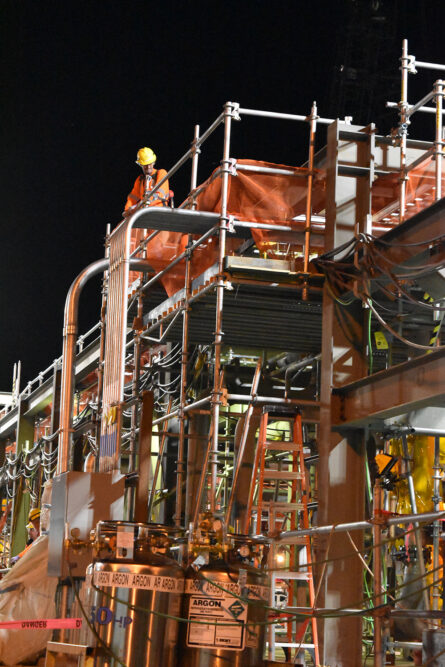
Home » Vit plant graveyard shift works to get it done after dark
Vit plant graveyard shift works to get it done after dark

September 12, 2019
By Darcy Richardson, Bechtel National Inc.
It happens overnight.
The Hanford Waste Treatment and Immobilization Plant job site changes and more progress is made, moving the project forward on its path to treating tank waste.
“We like to fly under the radar as much as possible, be the silent partners,” said Kelly Lofton, Bechtel National Inc. night shift superintendent. “If we can complete a job at night and the day shift comes in and asks—‘Wait, when did that get done?’—then I consider that a win.”
There are just under 200 employees who work the night shift, a little less than a tenth the size of the day shift. For people working in construction, the night shift starts at 6 p.m. and ends at 4 or 4:30 a.m. Superintendents start their days at 4 p.m. so they can do turnover with the day shift.
“The night shift expands the project’s work production, helping meet milestones and move us forward toward completion,” Lofton said. “Even with a small crew, we’re able to complete work the day shift is unable to complete.”
One of the biggest limitations for the day shift is congestion; there are simply more people and more equipment. Fewer people working can be a benefit, said Tracey Hagood, Effluent Management Facility, or EMF, piping superintendent.
“During the day, two or three crews would have to stop working if we wanted to move a lift or large piece of equipment,” she said. “We have more flexibility to move work around and work in areas that are hard to get to when there are more people, especially in a building with a small footprint like the EMF.”
About 40 pipefitters work the night shift, and they were responsible for installing the piping in the EMF utility support building. Since completing that in June, they are now installing instrumentation and preparing pressure tests.

A small group of non-union staff also make up the night shift, including the superintendents, field engineers, startup engineers, a construction technician, health and safety personnel, an administrative assistant and quality assurance personnel. However, limited access to staff creates challenges, and careful work planning and coordination is essential.
“Communication is the biggest challenge,” Lofton said. “Our superintendents come in at 4 p.m. to do turnover with the day shift. We have to work with the day shift to make sure that we both have what we need and that we’re supporting each other.”
This includes identifying work scope, answering questions, and ensuring the night shift has the right materials and equipment before the shift begins because getting them later can be difficult.
There are advantages to being on an overnight shift, said Bobby Campbell, electrical superintendent.
“I like the problem-solving aspect of working the night shift,” Campbell said. “There are less resources available to us, so we have to come together to answer questions and work through the issues we encounter.”
On the night shift, Campbell has about a dozen electricians who focus on installing cable in the Low-Activity Waste, or LAW, facility.
“I have a really talented crew,” Campbell said. “They know what they’re doing, they’re really good at it, and they take a lot of pride in what they do. We complete our work with quality, and our safety record shows that.”
In the last seven years, the electricians have pulled more than 900,000 feet of cable during the night shift, enabling the day shift to focus on other activities. They are also in charge of moving, setting up and removing temporary power.
“Our goal is for the day shift to come into work in the morning, and the temporary power is ready to go,” Campbell said. “They don’t even have to think about it; they can just start their work.”
Much like the electricians, the carpenters focus on preparing the job site for the day shift, primarily setting up and removing the large and sometimes complex scaffolding. The ironworkers are erecting structural steel in the EMF and responsible for building permanent and temporary stairs. Laborers provide general site support.
It’s not difficult to see why some people enjoy the night shift. The job site is relatively quiet compared to the hustle and bustle of the day shift. While there are still the unmistakable sounds of construction, there are fewer people moving about, radios going off and vehicles moving. It’s peaceful walking to the LAW Facility in the cool night air.
“I don’t miss the heat or the traffic, and I always get front-row parking,” Lofton said.
Just like the day shift, the night shift is working mandatory overtime at the job site, so there is not much opportunity or need to switch their internal clocks.
“It’s a different lifestyle,” Lofton said. “Family balance can be difficult because you’re sleeping when everyone else is awake. You have to have the support of your family, and you have to watch your vitamin D levels. But it’s quieter and easier to focus on getting the work done without the congestion and meetings.”
It’s clear the night shift crew is instrumental in helping WTP reach its goals, and they are proud of what they do.
“We’re one team,” Hagood said. “We’re all here—whether day shift or night shift—to complete the job while maintaining quality and keeping everyone safe.”
Local News
KEYWORDS september 2019




